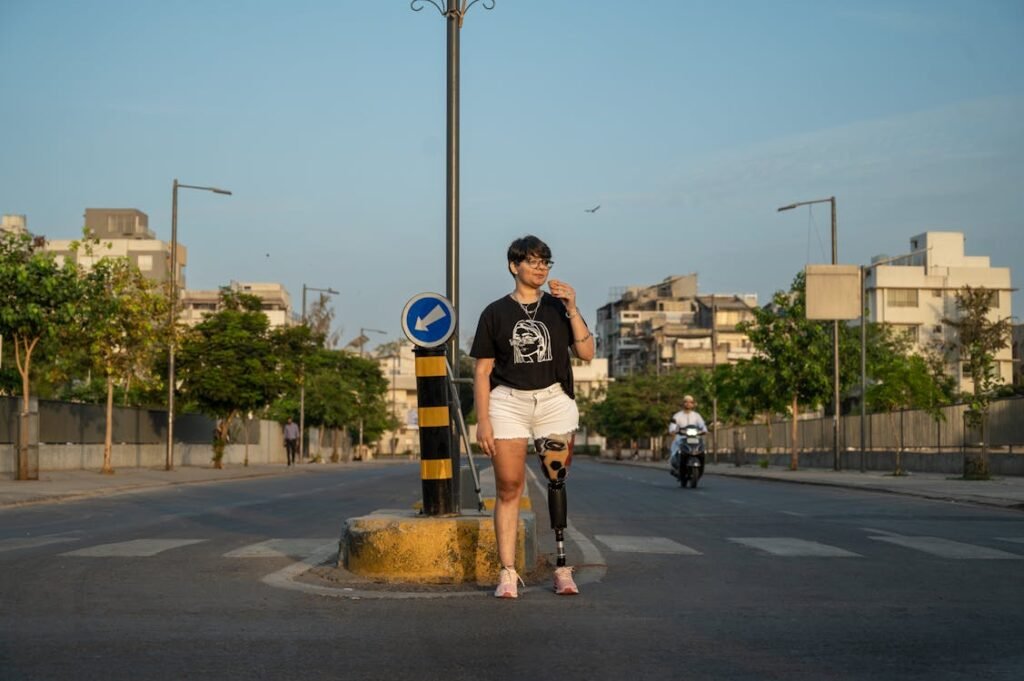The first time you stand between parallel bars with a prosthetic limb is unforgettable. Your heart might race. Your hands may grip the bars tightly. But more than anything, you’re filled with questions. Will I be able to walk on my own? How do I move from needing help to walking freely?
At Robobionics, we’ve stood beside hundreds of people taking those very first steps. We’ve seen the effort, the courage, and the quiet determination it takes to walk again. Moving from the support of parallel bars to walking independently with a prosthetic doesn’t happen overnight. It takes time, patience, and guided practice. But it’s absolutely possible—and incredibly rewarding.
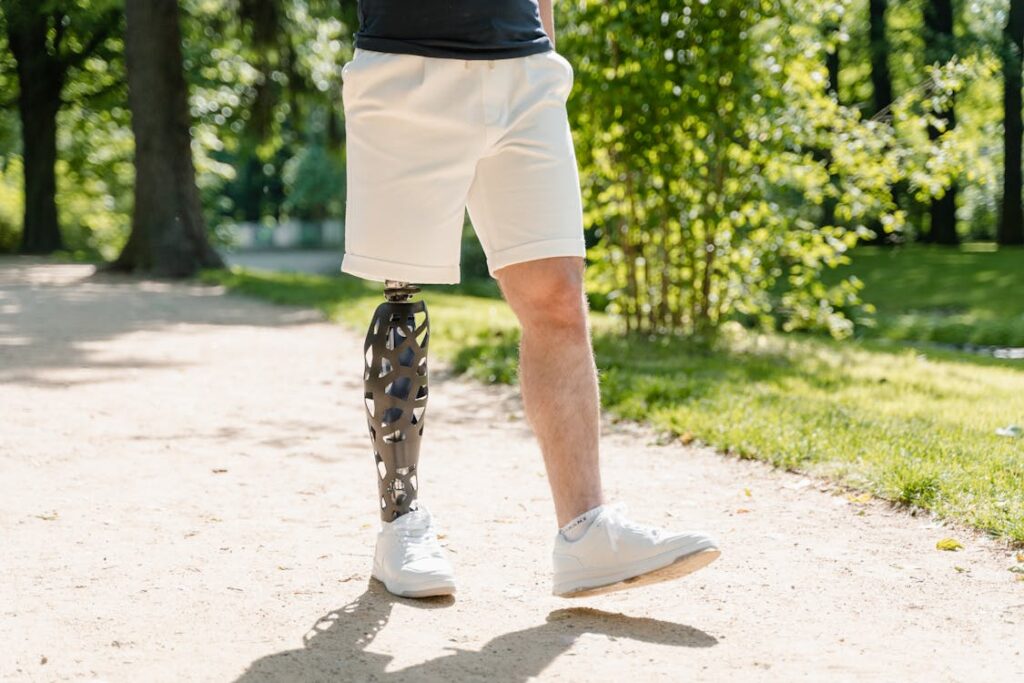
The First Steps: Learning to Trust the Prosthetic
Building a Foundation
When you first begin walking with a prosthetic, your world feels different. Your body moves in new ways. The floor feels unfamiliar beneath you. Even standing might take more effort than you expected. That’s why parallel bars are so important in the beginning. They offer stability and safety while your body and mind adjust to this change.
At this stage, you’re not just learning to walk again. You’re learning to trust again—trust your body, your balance, and the prosthetic limb itself. Most people feel unsure during their first few sessions. That’s completely normal. Even taking two small steps between the bars can feel like a big win. And it is.
Parallel bars help you focus on your posture and weight distribution without worrying about falling. You’re supported, but you’re also using your own muscles. Every movement, every tiny shift, teaches your brain and body how to work together in this new way. The confidence you build between the bars will become the base you’ll rely on when you’re finally walking without support.
Recognizing Progress
During the first few days or weeks, progress may feel slow. You might take short steps. You may feel tired easily. But something important is happening—your body is learning. Your muscles are beginning to remember what movement feels like. Your brain is forming new connections to control the prosthetic. Even if it doesn’t look like much from the outside, on the inside, real change is taking place.
We’ve seen patients who began with shaky steps, holding the bars with all their strength. Within days, their grip loosened. Their steps became more steady. Their gaze lifted. And most importantly, their fear faded. This isn’t magic—it’s muscle memory. The body is incredibly smart. It just needs time and gentle practice to learn again.
One of the best ways to see your growth is by how you feel while walking. Are you relying less on your arms? Do your steps feel more even? Are you starting to focus less on walking and more on where you’re going? These are signs that your body is adjusting well.
Learning Balance and Control
Walking with a prosthetic limb isn’t just about moving forward. It’s about maintaining balance and control with each step. When you lose a limb, your center of gravity changes. That means the way you hold your body, the way you shift your weight, and the way you react to movement all have to be relearned.
The parallel bars give you the perfect space to practice these adjustments. You can try moving your weight side to side, shifting from your sound limb to your prosthetic side. You can practice standing still, without leaning too much on the bars. You can even try gentle turns while staying safe and supported.
These movements may seem small, but they build the skills you’ll need outside the clinic. Imagine walking on a busy road, climbing a step, or standing in a moving bus. All of those things require balance. And the more you train for it now, the easier it will become later.
Balance also builds trust. Once your mind realizes that your prosthetic can support your weight, you’ll start to relax. You’ll stop overthinking every step. And that’s when walking begins to feel natural again.
Adjusting to the Prosthetic
Your prosthetic limb is a tool—but it needs to become part of you. At first, it may feel foreign. It may feel stiff or awkward. You may worry about every movement. That’s normal. But with time and use, it will begin to feel like an extension of your own body.
Every person is different. Some adapt quickly. Others need more time. Your comfort will depend on many things—your overall health, your strength, your energy, and how well your prosthetic fits. This is why we always recommend wearing the prosthetic for short periods at first, and gradually increasing your time with it as you build confidence.
During your sessions at the parallel bars, your prosthetist and physiotherapist will closely watch how your limb is moving. If the socket is causing pain or your gait looks uneven, they’ll make adjustments. A small tweak to the alignment can make a big difference in how you feel and move.
What matters most is that you speak up. If something feels off, let your therapist know. Don’t ignore discomfort. Walking should not be painful. With the right fit and consistent training, your prosthetic will begin to feel like a reliable part of your everyday life.
Transitioning the Mind
As you train your body to walk again, don’t forget to train your mind too. One of the biggest barriers to independence is fear. The fear of falling. The fear of failing. The fear of being seen as “different.”
This fear is real, and it’s okay to feel it. But it shouldn’t stop you from moving forward. That’s why your time at the parallel bars is also about building mental strength. Every successful step is proof that you are capable. Every moment of balance is a reminder that your life isn’t stuck—it’s in motion.
We encourage our patients to visualize success. Picture yourself walking down a path, crossing a street, or climbing stairs. Imagine it going well. Imagine the feeling of pride when you do it on your own. This kind of mental rehearsal has been shown to improve real-life performance. It also keeps your mindset positive, which is just as important as physical ability.
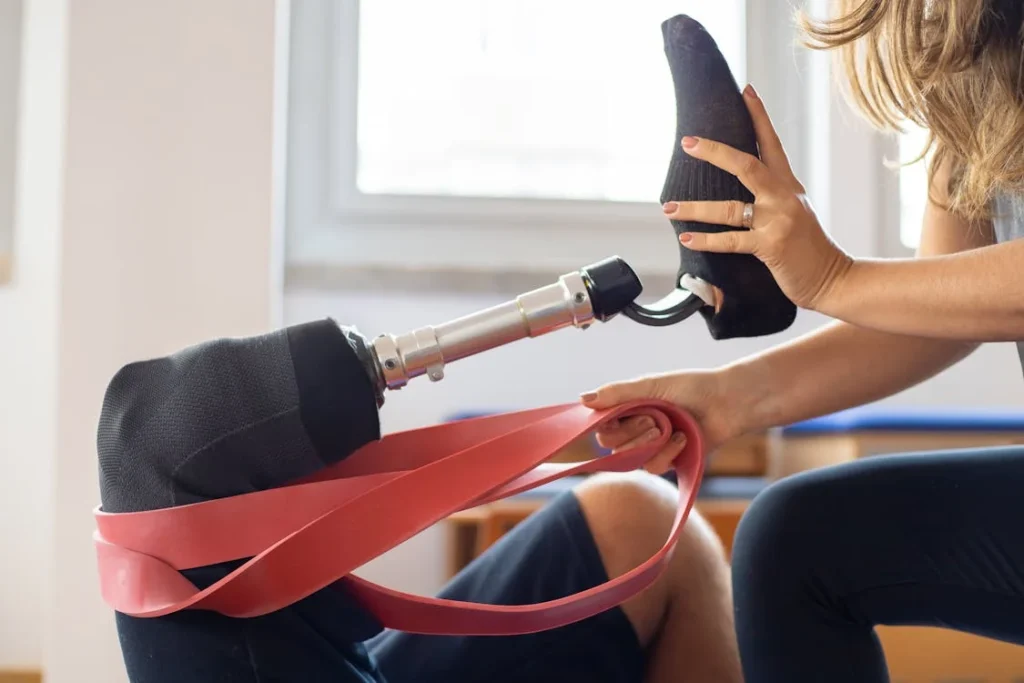
Gaining Strength: Moving Beyond the Bars
Letting Go Gradually
The day will come when your therapist says, “Try letting go of the bars.” For some, this moment is exciting. For others, it’s scary. But it always means one thing—you’re ready. Letting go doesn’t mean you’re suddenly walking across the room on your own. It simply means you’re beginning to rely more on yourself and less on the equipment around you.
We often start this step by having you hold the bars with just one hand. This helps your body adjust to less support while still keeping you safe. It may feel wobbly at first, and that’s okay. With every attempt, your balance improves. Soon, we ask you to place both hands above the bars, just hovering, so they’re there if needed—but not holding on. These exercises teach your legs and core muscles to do more work. They teach your body to stabilize naturally.
Even shifting from gripping to a light touch can build your balance quickly. It’s a way of reminding your brain, “You’ve got this.”
Introducing a Walking Aid
After mastering some balance without the bars, most people use a walking aid as their next step. This could be a walker, a crutch, or a cane. It gives you support while also allowing you to move freely in open space.
This transition is important because it prepares you for real-world walking. Outside the clinic, there are no bars. But life comes with walls, railings, counters, and other surfaces you can use for support. A walking aid mimics this idea—it’s there when you need it, but it doesn’t trap you in one place.
We’ve seen patients who began using a walker just to move across a room. A few days later, they were walking down hallways. Then they were climbing ramps. And within a few weeks, many moved to just using a stick or nothing at all.
Don’t rush this phase. It’s not about how quickly you leave the aid behind—it’s about how steady and confident you become while using it.
Practicing in Real Environments
Clinic floors are smooth. Hallways are wide. But life isn’t always so simple. That’s why we begin practicing in environments that mimic daily life. You might be asked to walk across a room with chairs in the way. You may step onto a ramp or walk over a soft mat that mimics grass. These challenges prepare you for sidewalks, elevators, and markets.
We even simulate activities like turning to answer someone behind you or walking through a door. These moments are common in daily life, and they require coordination and spatial awareness. The more you practice them in a safe space, the easier they become when you’re truly out and about.
One of our patients, Nandakumar, wanted to be able to walk to his neighborhood shop to buy groceries again. So, we created a setup in the clinic with narrow lanes and shelves. At first, he bumped into things. But day by day, his confidence grew. Today, he visits the market every evening, walking proudly with his shopping bag.
These practical sessions aren’t just about physical ability—they’re about regaining life.
Strengthening Core and Supporting Muscles
Walking with a prosthetic limb uses more energy and more muscle groups than you might expect. That’s why strengthening your body—especially your core, hips, and thighs—is a big part of the transition.
You don’t need fancy gym equipment for this. Simple exercises like standing leg lifts, gentle squats, and side-to-side stepping can build strength. These exercises also improve your endurance, helping you walk longer without fatigue.
As you grow stronger, your movements become smoother. You’ll notice less limping, better posture, and fewer awkward shifts. Your body will begin to feel more balanced—and walking will feel more natural.
One key point we always stress is posture. Walking with your head up and shoulders back makes a big difference. It keeps your body aligned, improves your balance, and helps your prosthetic function better. We sometimes use mirrors during training so patients can see their own gait. That visual feedback helps correct small mistakes and builds awareness.
Managing Uneven Ground and Obstacles
Once you’ve built confidence in flat areas, we begin introducing uneven surfaces. This is where your skills are really tested. Life is full of uneven terrain—gravel roads, staircases, slippery tiles, and more. Your ability to adjust your walk and keep your balance on these surfaces is what makes you truly independent.
We help patients learn how to scan their environment with their eyes, read the ground, and take each step with intention. Walking slowly and carefully on these surfaces helps train the brain to make smart choices. We often say, “Look before you step, but don’t freeze.”
You’ll learn how to position your prosthetic when climbing a stair, how to push off when walking uphill, and how to maintain control on a slope. These aren’t just skills—they’re confidence builders. Knowing you can walk safely anywhere means you can go anywhere.
One inspiring story is of Jaya, a retired schoolteacher who wanted to visit her temple again. The temple had uneven stone paths and stairs without railings. Through focused training, we helped her practice walking on similar surfaces. Eventually, she climbed the temple steps and rang the bell with tears in her eyes.
It’s these small victories that remind you—you’re not just walking. You’re living.

Overcoming Mental Barriers and Gaining Confidence
Breaking Through the Fear of Falling
No matter how strong your body becomes, fear can still hold you back. The fear of falling is one of the biggest mental blocks people face after limb loss. It creeps in when you’re about to take a step without support or try walking on unfamiliar ground. That fear is valid. It’s a way your mind tries to protect you. But if left unchecked, it can stop you from moving forward.
At Robobionics, we don’t just train the body—we help train the mind too. One of the best ways to overcome the fear of falling is through controlled exposure. We practice “safe stumbles,” where patients learn how to regain balance when they start to tip. We teach them how to fall safely and how to get back up without panic. These drills build not just skills, but confidence.
Once you experience a controlled fall and realize you’re okay, the fear starts to loosen its grip. You learn that your prosthetic is strong. That your body knows how to respond. And most importantly, that you have the strength to recover. That feeling changes everything.
Setting Small, Achievable Goals
Success doesn’t always come in leaps—it often comes in small steps. One of the most effective ways to stay motivated is by setting short, achievable goals. These aren’t just physical goals. They’re emotional wins too.
For example, the goal might be as simple as walking across the living room without holding onto furniture. Or taking a walk outside around your house. Or going up one flight of stairs independently. These milestones may look small from the outside, but each one is a breakthrough.
We had a patient named Satish who was anxious about walking into crowded areas. So his first goal was to take a walk in his own backyard. Once he did that comfortably, he tried walking to the front gate. A week later, he walked to the nearby park with his son. Within a month, he was navigating a shopping mall on his own. Each step built the belief that he could go further.
By setting goals that are specific and achievable, you give yourself something to look forward to. And every time you reach one, you get a powerful reminder—you’re making real progress.
Understanding Your Own Pace
One of the biggest mistakes people make is comparing their journey to someone else’s. Recovery is not a race. Some people walk independently in a few weeks. Others may take months. Both are perfectly normal. Your journey is yours alone.
There will be days when walking feels easy, and others when it feels hard. That’s okay. What matters is showing up and giving your best for that day. Some days, your body may feel tired. Other days, your mind may need a break. Listen to both. Progress isn’t about constant forward motion. It’s about staying consistent and kind to yourself.
We often remind our patients: Don’t measure your success in distance. Measure it in effort. Every time you try again, even after a tough day, you are succeeding.
Getting Comfortable in Public Spaces
The first time you walk in a public place without help can be emotional. You might feel exposed. You might worry about stares or questions. But you also might feel free.
This part of the transition is deeply personal. We always suggest starting in familiar places. A friend’s house. A quiet park. A local store where people know you. These places feel safer and help ease you into the outside world.
Over time, you’ll start walking in more public places—markets, bus stations, restaurants, temples, or even train platforms. At first, you may feel self-conscious. But as you walk more confidently, you’ll notice something surprising: most people aren’t looking at your prosthetic. They’re looking at your strength.
We worked with Arpita, a college student who was hesitant to return to class. She was worried about being seen differently. With support and training, she regained her stride. When she walked into college again, she didn’t just blend in—she stood out as someone who had overcome something great. Her classmates welcomed her back with open arms.
Being seen walking independently isn’t something to fear. It’s something to be proud of.
Handling Setbacks With Grace
Every journey has bumps. You might trip one day. You might feel sore another. You might have a week where everything feels harder. These setbacks are not failures. They’re part of the process.
What matters is how you respond to them. At Robobionics, we teach patients to see setbacks as temporary. They’re signals, not stop signs. Maybe you need to rest. Maybe your socket needs adjusting. Maybe your mind needs a moment to breathe. All of these are valid.
Some of our most successful patients have had tough starts. But what made the difference was their willingness to keep going. They took breaks when needed. They asked for help. And they always got back up.
You are not weaker for needing rest. You are stronger for not quitting.
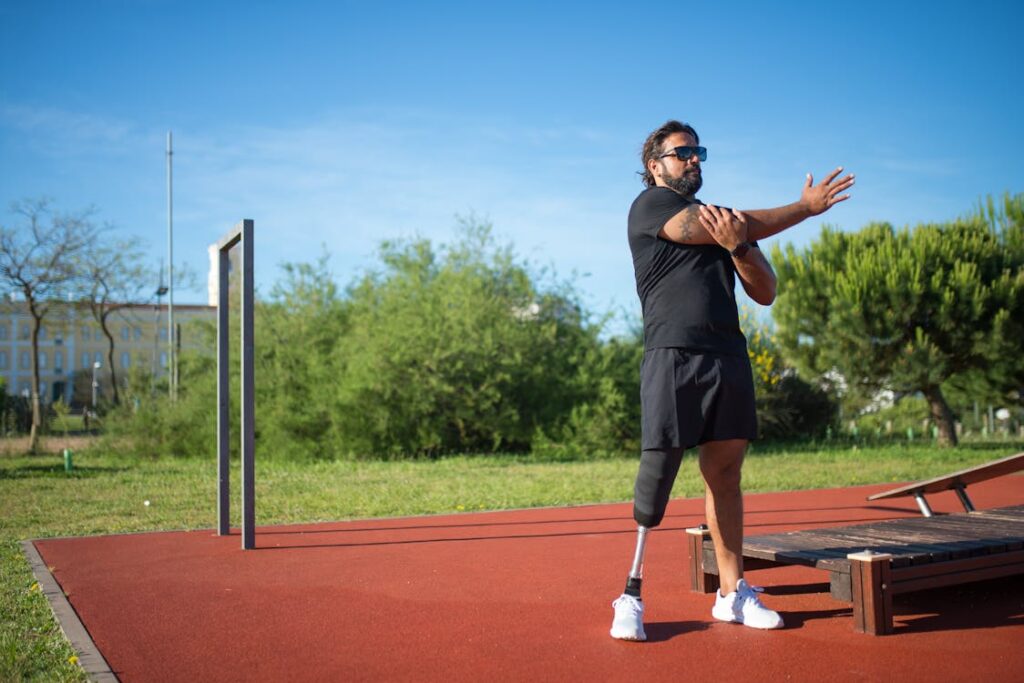
Walking Into Independence: Daily Life with Confidence
Mastering Home Environments
Once you’ve built strength, balance, and confidence in structured settings, your home becomes your primary training ground. It’s where you’ll be walking the most—and where independence truly begins. But home is also full of hidden challenges: slippery floors, tight corners, stairs, rugs, and low furniture.
At Robobionics, we help patients prepare for these real-world hurdles. It starts by making small changes at home to support safer movement. Keeping walkways clear, using non-slip mats, and installing sturdy handrails near steps or bathrooms can make a big difference. These changes don’t just improve safety—they build your ability to move around with less worry.
Your routine becomes the new training session. Walking from your bed to the bathroom, standing in the kitchen while making tea, opening a door while holding something—these everyday activities are great for building natural balance and coordination. They also bring back that sense of control, where you’re no longer depending on someone for every task.
One of our patients, Mary Fernandes, shared that the first time she cooked a full meal while standing with her prosthetic, she cried. Not out of pain—but pride. She was back in her element, not just surviving, but living.
Returning to Work or Social Life
The transition back to work or a social setting is often filled with emotion. There’s excitement, nervousness, and sometimes even doubt. Can I keep up? Will others understand what I’ve gone through? What if someone stares?
The truth is, most people are more supportive than you might expect. They’re not judging you—they’re inspired by you. And if you walk into your workplace or gathering with self-belief, people will see that strength first.
Before returning to work, it helps to talk with your employer or colleagues. Let them know about any minor adjustments you might need. A chair with better back support, perhaps, or a designated space to take short breaks if needed. Small accommodations go a long way, but more than that, they give you peace of mind.
Social settings might bring new concerns. Will you be able to stand for long periods? Can you navigate a crowded room? That’s where your gait training pays off. All those drills in the clinic—the turns, the uneven surfaces, the standing exercises—prepare you for these moments.
We remember Mr. Azhar, a shopkeeper from Jaipur. He feared returning to his store, thinking his customers would lose confidence in him. But on the day he reopened, not only did they come back—they brought others with them. They were proud of his recovery. His business didn’t suffer—it grew. Because strength is good for business, too.
Embracing Your New Normal
There comes a moment when the prosthetic isn’t something you think about constantly. It’s just part of you. You stop noticing every step. You stop checking the ground under your feet. You begin to live again—fully and naturally.
This is what we call your “new normal.” It may look different from your life before limb loss, but it’s still rich, full, and meaningful. You’ll find new routines. You might pick up new hobbies. You’ll rediscover old passions from a fresh perspective.
One of our youngest patients, Sohail, loved cycling before his accident. After training, he was nervous to try again. We guided him through balance exercises and worked on leg strength. After three months, he was riding again. He now mentors other young amputees who want to stay active.
Your new normal can include everything from fitness to travel, art to education, work to parenting. A prosthetic doesn’t put limits on your life—it opens a new way to experience it.
Staying in Tune With Your Body
As you continue walking independently, it’s important to stay in tune with your body. Pay attention to how your limb feels after long walks. Notice any new pressure points, swelling, or discomfort. These are your body’s signals. They don’t mean you’ve failed—they just mean something might need adjusting.
Over time, your residual limb may change shape slightly. That’s normal. It may mean your socket needs to be refitted. Your walking pattern might change as your muscles grow stronger. All of this is part of your evolving journey.
We recommend regular follow-ups with your prosthetist. These check-ins help catch small issues before they become big ones. They also give you a chance to ask questions, get reassurance, and learn new tips for care and comfort.
At Robobionics, many of our patients continue visiting us even after full recovery—not because they have problems, but because they know the value of being proactive. They stay one step ahead, both physically and emotionally.
Giving Back and Inspiring Others
One of the most powerful moments in a person’s recovery is when they realize their story can help someone else. What you’ve gone through—the fear, the work, the triumph—it all has meaning. You become a source of strength for someone just beginning their journey.
Some people choose to share their experience online. Others speak to small groups at hospitals or support centers. Some even volunteer at rehabilitation clinics to offer comfort and advice.
This kind of support is priceless. It brings hope where there is doubt. It says, “I’ve been there, and look—I’m walking now.” That message changes lives.
We’ve seen incredible ripple effects. One patient’s success story inspired three more people to begin gait training. A daughter’s recovery helped her father believe he could heal, too. A video of a man walking for the first time brought tears—and motivation—to people he’s never even met.
You don’t need a stage to inspire. You only need your story.

The Role of Emotion and Identity in the Walking Journey
Reclaiming Who You Are
The transition from parallel bars to independent walking is not only about training muscles—it’s about reconnecting with your sense of self. After limb loss, many people experience a quiet identity crisis. You don’t just lose a part of your body—you may feel like you’ve lost a part of who you were.
Perhaps you used to be active and now feel limited. Maybe you were independent and now find yourself relying on others. For some, the mirror becomes a reminder of what’s changed. These silent emotional shifts are often overlooked—but they’re real, and they matter.
Walking again isn’t just physical progress—it’s emotional healing. Every step forward chips away at the feeling of loss and begins to restore confidence, dignity, and agency. As your gait becomes steadier, your voice often becomes stronger. You start speaking with more assurance. You look people in the eye again. You move through spaces without apology.
We’ve seen patients reintroduce themselves to the world—not as someone with a disability, but as someone with strength, experience, and a renewed sense of purpose.
The Emotional Weight of “Firsts”
There are many “firsts” after limb loss that carry deep emotional weight. The first walk without bars. The first time out in public. The first trip to the store. These aren’t just tasks. They’re emotional markers.
We worked with a man named Bhupen who delayed attending his daughter’s school function for months because he didn’t feel ready. When he finally walked into that auditorium, the look on her face made every struggle worth it. Later, he said, “I didn’t just walk—I showed her that I’m still her hero.”
These milestones are powerful because they tie movement to meaning. Walking becomes a way to reclaim roles in your life—as a parent, a partner, a professional, a friend. The physical step and the emotional step happen together—and that’s where true transformation lives.
Identity Beyond the Prosthetic
Over time, the prosthetic becomes part of your story—but not your whole story. It stops being the center of attention. You stop defining yourself by it. People around you do, too.
You become known not for the limb you lost, but for how you chose to live after. You are seen not for what you went through, but for who you’ve become.
That shift in identity is profound. It means you’re no longer in a state of recovery—you’re in a state of becoming. And the best part? You get to decide what that looks like.
Whether you want to travel, start a business, go back to school, or mentor others, your prosthetic doesn’t hold you back. It goes with you.
Rebuilding Emotional Resilience
Alongside physical strength, walking independently rebuilds something even more important—resilience. This is the quiet power to keep going, even when it’s tough. It’s the strength to try again after a bad day. The ability to sit with frustration without giving in to it. The skill of celebrating small wins.
These emotional muscles grow just like physical ones—with use. Every challenge faced during your walking journey is a chance to become mentally stronger.
We’ve seen people cry in frustration one day and smile in triumph the next. We’ve seen silence turn into laughter. That emotional bounce-back is a huge part of recovery. It means you’re not just surviving—you’re adapting, responding, and thriving.
Emotional Closure and New Beginnings
There’s also something quietly beautiful that happens when you reach a point of walking independently—you begin to let go of what was lost. Not in a way that erases the past, but in a way that makes peace with it.
You may visit places you’ve been avoiding. You may look at old photos with gratitude instead of sadness. You may find the courage to plan for the future again—not with fear, but with excitement.
Walking, in this sense, becomes symbolic. It means you are moving forward, not just through space, but through life. With every stride, you’re telling the world—and yourself—that you’re not defined by what happened to you, but by how you chose to rise.

How Nutrition and Lifestyle Impact Your Prosthetic Walking Journey
Fueling Your Steps from Within
When people think of learning to walk again with a prosthetic, they usually picture exercises, therapy sessions, and physical drills. But there’s a quiet partner to all that hard work—nutrition. What you eat can have a powerful effect on how well your body adapts, recovers, and performs during your gait training journey.
Think of your body as an engine. Your muscles, joints, nerves, and even your mood are all influenced by the fuel you give it. Eating nourishing foods doesn’t just keep you healthy—it directly affects your energy levels, tissue healing, muscle strength, and stamina during rehabilitation.
At Robobionics, we encourage patients to view food not as an afterthought, but as part of the training itself. A patient who’s well-nourished moves better, recovers faster, and faces fewer complications.
Protein and Muscle Recovery
When you’re learning to walk with a prosthetic, your muscles are working overtime. They’re adjusting to new roles, compensating for lost movement, and building strength with every step. That means they need proper repair—and protein is the building block that makes that happen.
Whether it’s from dals, milk, eggs, tofu, or lean meats, regular intake of protein helps your muscles recover from the strain of therapy. It also supports the development of core and leg strength, both essential for maintaining balance and preventing fatigue as you move away from the parallel bars.
One of our patients, Aman, used to feel extremely sore after every gait training session. Once we helped him adjust his diet to include small, regular portions of protein-rich foods, his energy returned, and his recovery periods shortened noticeably.
Staying Hydrated and Reducing Inflammation
Walking with a prosthetic requires coordination between your limbs, joints, and muscles. Dehydration can reduce flexibility and increase cramping, both of which make walking harder. Even mild dehydration can affect balance and focus.
Drinking water throughout the day is key, especially after physical activity. For those doing long sessions of gait training, coconut water, lime water with a pinch of salt, or simple herbal teas can also help replenish lost minerals.
On top of that, certain foods help reduce inflammation in the body, which is important when you’re dealing with residual limb soreness or the minor joint strain that comes with using a prosthesis. Turmeric, ginger, garlic, leafy greens, and omega-3-rich seeds like flaxseed can quietly support your recovery in the background, one meal at a time.
The Energy Connection: Managing Fatigue
One thing many new prosthetic users don’t expect is how tiring walking can be in the early stages. It’s not just physical. Your brain is learning, your muscles are compensating, and your body is using more energy than before.
This is why eating at the right times matters just as much as what you eat. Skipping meals or going too long without eating can leave you drained right before a training session. A small meal or snack with healthy carbs—like fruit, brown rice, or even a banana with peanut butter—can give you the boost you need to power through.
Balanced meals help you go the distance, not just for therapy but for daily life. We’ve often seen patients report better moods and improved sleep simply from improving their meal routines.
Supporting Skin and Socket Health
The area where your prosthetic socket meets your skin is extremely sensitive. Maintaining the health of your skin and soft tissues is a key part of comfortable, safe walking. Infections, rashes, or blisters can quickly slow your progress or even stop you from walking altogether.
A diet rich in vitamins A, C, and E supports healthy skin and helps repair minor skin damage faster. Carrots, papayas, spinach, oranges, nuts, and seeds can all be powerful allies in this area.
Zinc-rich foods like pumpkin seeds, lentils, and paneer can further aid tissue repair, especially for patients who experience friction issues in their socket area.
It’s also important to manage your blood sugar levels, especially for patients with diabetes-related amputations. Blood sugar control impacts wound healing, skin health, and nerve sensitivity—three things that are essential for a successful transition to walking independently.
Sleep and Emotional Well-being
Nutrition doesn’t act alone. Your lifestyle choices—especially sleep—can shape how your body recovers and performs during training. Without proper rest, your muscles can’t rebuild, your joints don’t reset, and your energy stays low.
Patients who sleep poorly tend to feel more frustrated and report lower motivation. On the other hand, those who sleep well and maintain a balanced lifestyle often show more consistency in their therapy.
Eating heavy meals late at night, relying too much on caffeine, or staying glued to screens can affect your sleep cycle. Gentle evening routines, light dinners, and a calming space for rest all contribute to a better emotional and physical recovery experience.
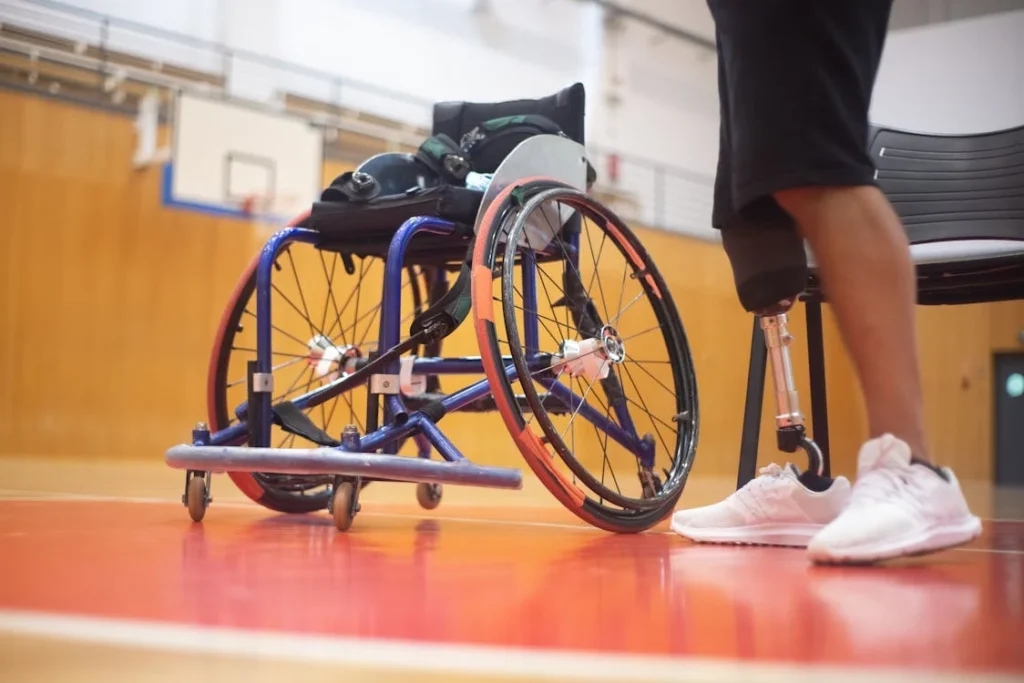
The Role of Sound and Rhythm in Enhancing Gait Training
Walking to a Beat: How Rhythm Shapes Movement
When we think of walking, we often see it as a purely mechanical action. But in truth, walking is rhythm. Each step has a beat, a pattern, a flow. This rhythm is often disrupted after limb loss. The brain, which once relied on years of habitual movement, suddenly needs to relearn how to coordinate steps again—this time with a prosthetic limb.
That’s where rhythm—and sound—can play a powerful role in retraining the body.
At Robobionics, we’ve found that using rhythmic cues, like metronomes, clapping, or even soft background music, can help patients find a natural walking cadence. When a beat is consistent, the body begins to align with it. Step by step, rhythm helps restore balance, smoothness, and timing.
Music as a Motor Tool
Music isn’t just a mood booster. It’s a training tool. Listening to a steady beat while walking helps your brain predict when the next step should occur. This allows for more even stride lengths, better weight shifts, and improved coordination between the residual limb and the prosthetic.
We had a patient named Rina, a dance enthusiast, who struggled with timing during her early sessions. Her steps were inconsistent, and she often paused mid-stride. Then we introduced soft instrumental music with a clear tempo into her training. Slowly, her steps began to sync with the beat. Within weeks, her entire gait improved—not just in function, but in confidence and grace.
Even people who don’t consider themselves musical respond to rhythmic patterns. It taps into a primal part of the brain that helps regulate movement.
Building Consistency Through Beat
One of the most common challenges in gait training is inconsistency. A patient may start strong, but their pace might change with fatigue, distraction, or terrain. Using rhythmic training—such as tapping feet to a beat, walking with a metronome, or playing a repetitive drum loop—creates consistency. It turns walking into something almost automatic again.
This technique is especially helpful for patients who feel hesitant or overthink each movement. Instead of focusing on each step with intense concentration, the rhythm takes over and gently guides them forward.
Over time, the beat becomes internalized. Even when the music stops, the body remembers the pattern. That’s when the rhythm has done its job—it has retrained your walking memory.
Sound as Feedback
Apart from guiding motion, sound also serves as valuable feedback. The sound of your steps—how your prosthetic foot strikes the ground, how your other foot responds—can reveal a lot about your walking pattern.
In therapy, we often ask patients to listen to their walk. Is one step louder than the other? Is there a dragging sound? Is the rhythm even? These audio clues are incredibly useful in adjusting stride and improving balance.
Some advanced prosthetic limbs now even come with built-in auditory feedback systems that provide cues when posture is off or pressure is uneven. While not everyone needs or wants tech-based feedback, even the simplest awareness of step sounds can make a huge difference in gait quality.
Emotional Impact of Music During Training
Finally, there’s the emotional layer. Music uplifts. It motivates. It breaks the silence of focused walking and turns each session into an experience rather than a chore. Patients who train with music often report less fatigue and more enjoyment. This emotional lift matters. It keeps people engaged and eager to come back for the next session.
We’ve even had patients create their own playlists—songs that energize them, calm them, or remind them why they’re walking in the first place. For one patient, it was an old wedding song. For another, a bhajan she remembered from childhood. For many, music becomes the invisible companion that walks beside them on the road to recovery.
Conclusion
Learning to walk again with a prosthetic isn’t just about steps—it’s about self-belief. The journey from parallel bars to independent walking is filled with challenge, but also filled with growth. Every wobble leads to balance. Every small win builds strength—not just in the body, but in the heart.
At Robobionics, we’ve seen how the right mix of therapy, mindset, nutrition, rhythm, and emotional support turns hesitation into confidence. Walking again means reclaiming your identity, your routine, and your voice in the world. It means living—not just surviving.
You are not defined by what you’ve lost, but by what you choose to rebuild. With each step, you’re not only moving forward—you’re writing a new chapter of strength, courage, and resilience.
The path may start between two bars, but it leads to a life with no limits. And remember—every journey begins the same way.
With just one step.



